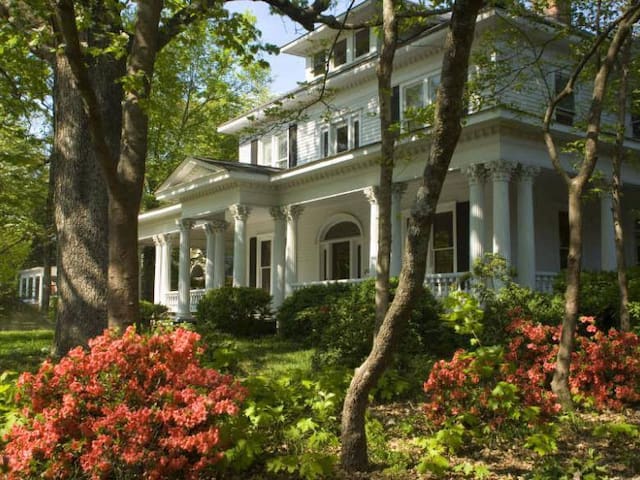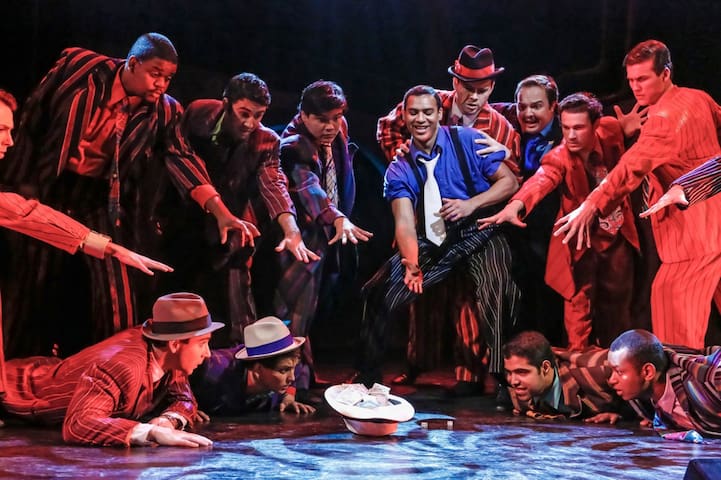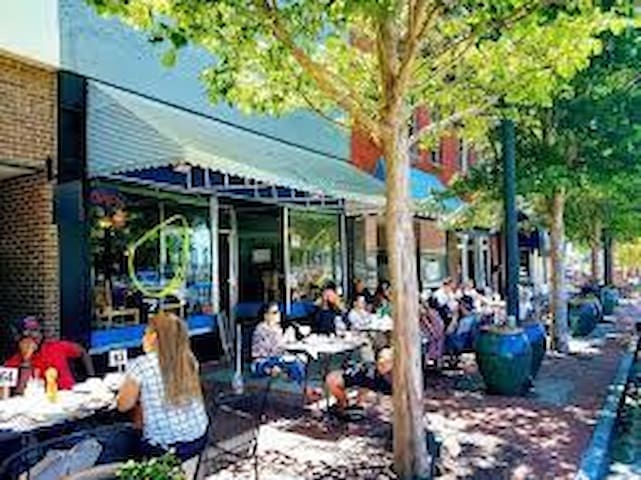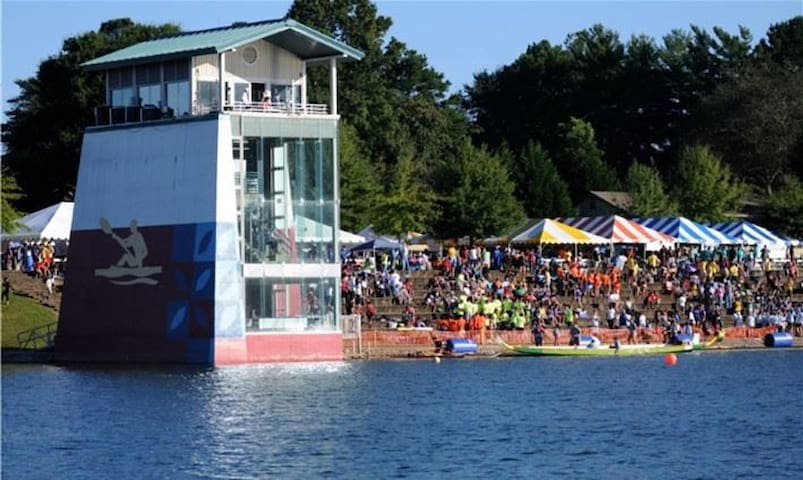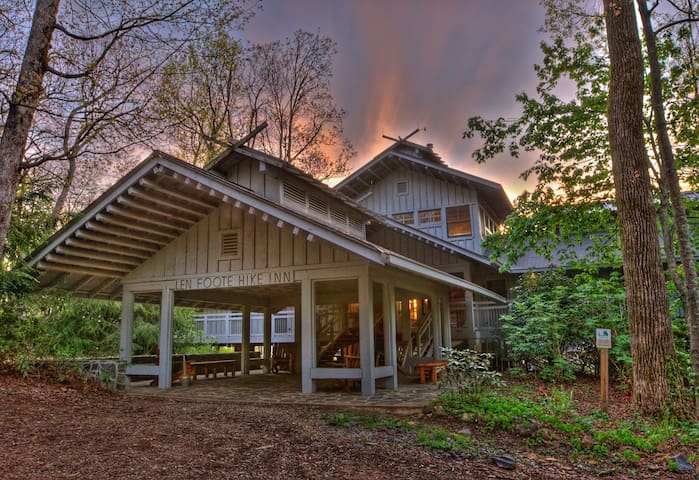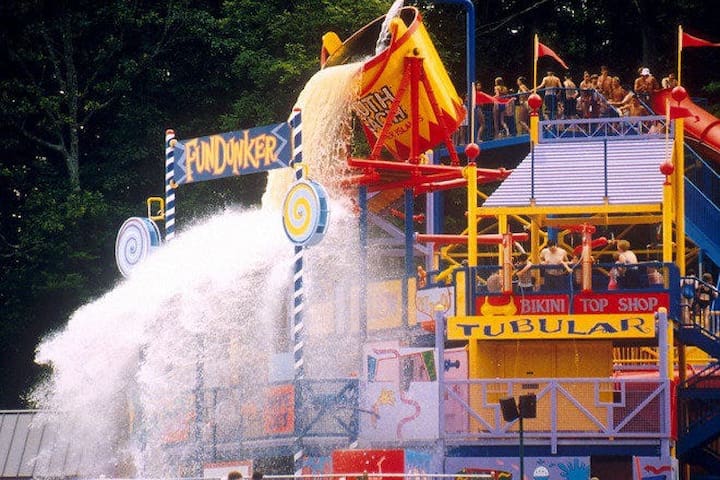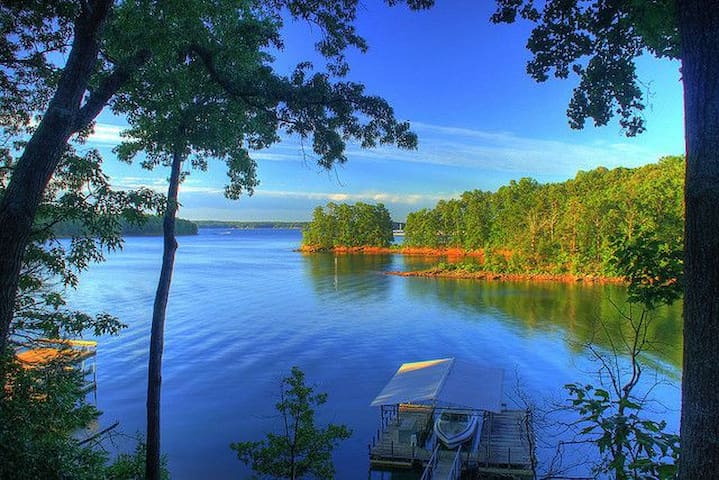Our favorite things to do!
Green Street Historic District
This row of Antebellum homes is remarkable, and each person in our family has their favorite house in which we fantasize about living. They’re almost all businesses now, but it’s a great way to walk to the Square if you’re not in a hurry. They close down one night in early December for “Christmas on Green Street,” when many of the homes are open for visitors.
Green Street is also home to the Quinlan Art Center, a small, FREE little museum with changing exhibits that showcase regional and local artists, and some who winter in the South. They have a nice gift shop and offer classes for all ages throughout the year.
A few blocks east of Green Street is Brenau University (pronounced Breh-NOW). It is an historic Women’s College with a lovely campus and some of the finest performance venues in town. They have quite an art collection as well; stop in to admire Pearce Auditorium, an 1890s Opera House and live theatre, and the adjacent (and free) art galleries. The good people inside can tell you where else in town galleries are currently open for viewing.
Green Street
Green StreetGreen Street Historic District
This row of Antebellum homes is remarkable, and each person in our family has their favorite house in which we fantasize about living. They’re almost all businesses now, but it’s a great way to walk to the Square if you’re not in a hurry. They close down one night in early December for “Christmas on Green Street,” when many of the homes are open for visitors.
Green Street is also home to the Quinlan Art Center, a small, FREE little museum with changing exhibits that showcase regional and local artists, and some who winter in the South. They have a nice gift shop and offer classes for all ages throughout the year.
A few blocks east of Green Street is Brenau University (pronounced Breh-NOW). It is an historic Women’s College with a lovely campus and some of the finest performance venues in town. They have quite an art collection as well; stop in to admire Pearce Auditorium, an 1890s Opera House and live theatre, and the adjacent (and free) art galleries. The good people inside can tell you where else in town galleries are currently open for viewing.
Gainesville Theatre Alliance
To the surprise of many who relocate here, Gainesville’s local college theatre program has been ranked one of the top professional theatres in the state.
GTA is a collaboration between Brenau University and the University of North Georgia and has historically focused on a vibrant guest professionals program, employing professional actors and designers from Atlanta and throughout the country to keep the bar high and connect students to a professional network after graduation. They typically perform in November, February and April with a few smaller productions at other times. gainesvilleTHEATREalliance.org
Gainesville Theatre Alliance
2900 Landrum Education DriveGainesville Theatre Alliance
To the surprise of many who relocate here, Gainesville’s local college theatre program has been ranked one of the top professional theatres in the state.
GTA is a collaboration between Brenau University and the University of North Georgia and has historically focused on a vibrant guest professionals program, employing professional actors and designers from Atlanta and throughout the country to keep the bar high and connect students to a professional network after graduation. They typically perform in November, February and April with a few smaller productions at other times. gainesvilleTHEATREalliance.org
Atlanta Botanical Garden ~ Gainesville
Thanks to a grand gift of land by Gainesville’s late first lady of philanthropy Lessie Smithgall, the Atlanta Botanical Garden invested in a wonderful garden for the people of northeast Georgia.
Currently a small meandering trail with eye-popping landscaping, seasonal displays and a babbling brook that runs throughout, it also has a grand amphitheater where name acts perform in warmer months and a newly expanded children’s garden. It is a great place to go for programming and evening wine tasting in the garden.
Atlantabg.org
46 Einheimische empfehlen
Botanischer Garten Atlanta, GAINESVILLE
1911 Sweetbay DrAtlanta Botanical Garden ~ Gainesville
Thanks to a grand gift of land by Gainesville’s late first lady of philanthropy Lessie Smithgall, the Atlanta Botanical Garden invested in a wonderful garden for the people of northeast Georgia.
Currently a small meandering trail with eye-popping landscaping, seasonal displays and a babbling brook that runs throughout, it also has a grand amphitheater where name acts perform in warmer months and a newly expanded children’s garden. It is a great place to go for programming and evening wine tasting in the garden.
Atlantabg.org
Gainesville Square
This is the center of things – complete with “Old Joe,” erected by the Daughters of the Confederacy around 1880 but using a clearance soldier from the Spanish and American War. The blossoming trees encircling him are glorious in Spring. There is a Friday afternoon farmer’s market here from May to October, and frequent live music or festival events that you can enjoy (see the City of Gainesville website). We used the Square as our living room while building a house – with various restaurants and shops hosting cocktail hours, children’s birthday parties and more. (Check out Rahabs Rope, jewelry, pashminas and home goods made by women in India learning trades to escape the sex trade.)
Don’t miss Roosevelt Square, next to the courthouse on the SE corner of the Square – named for FDR when he came to commemorate the dead after twin tornedos struck in 1936… it’s a great place to enjoy some green space and takeout. You can also walk a scale model of the solar system beginning at the “SUN” nearby (SE corner inside the Square)… which leads you through the in-town park system, alongside the lake and out to the poor disenfranchised former 9th planet.
Main Street Market
112 Main Street SouthwestGainesville Square
This is the center of things – complete with “Old Joe,” erected by the Daughters of the Confederacy around 1880 but using a clearance soldier from the Spanish and American War. The blossoming trees encircling him are glorious in Spring. There is a Friday afternoon farmer’s market here from May to October, and frequent live music or festival events that you can enjoy (see the City of Gainesville website). We used the Square as our living room while building a house – with various restaurants and shops hosting cocktail hours, children’s birthday parties and more. (Check out Rahabs Rope, jewelry, pashminas and home goods made by women in India learning trades to escape the sex trade.)
Don’t miss Roosevelt Square, next to the courthouse on the SE corner of the Square – named for FDR when he came to commemorate the dead after twin tornedos struck in 1936… it’s a great place to enjoy some green space and takeout. You can also walk a scale model of the solar system beginning at the “SUN” nearby (SE corner inside the Square)… which leads you through the in-town park system, alongside the lake and out to the poor disenfranchised former 9th planet.
Lake Lanier Olympic Venue
The only surviving venue of the 1996 Atlanta Olympics still used for its original purpose is the Lake Lanier Olympic Park, 15 minutes away. It is home to both the Lanier Rowing Club and the Lanier Canoe & Kayak Club, and continues to host international competition and spring training for competitive international and college teams. (We’ve even hosted Canadian kayakers for a month of training – charming!)
Check their website for open houses and classes – LCKC even has moonlight paddles for novices for a nominal fee each summer night that the moon is full.
14 Einheimische empfehlen
Lake Lanier Olympic Park
3105 Clarks Bridge RdLake Lanier Olympic Venue
The only surviving venue of the 1996 Atlanta Olympics still used for its original purpose is the Lake Lanier Olympic Park, 15 minutes away. It is home to both the Lanier Rowing Club and the Lanier Canoe & Kayak Club, and continues to host international competition and spring training for competitive international and college teams. (We’ve even hosted Canadian kayakers for a month of training – charming!)
Check their website for open houses and classes – LCKC even has moonlight paddles for novices for a nominal fee each summer night that the moon is full.
Elachee Nature Science Center
Elachee is a nature preserve that focuses on training the next generation of naturalists as we enjoy and study the natural world. They host field trips and campers for school-aged children year round, but also have a variety of FREE, wooded hiking trails that can be great in any season.
Trails go over hill and dale, up and down the naturally hilly terrain, and dogs on a leash are welcome. There is also a Nature Center and gift shop, a display of snakes in a room off the lower patio and an enclosure for 2 rescued hawks. Elachee.org
16 Einheimische empfehlen
Elachee Nature Science Center
2125 Elachee DrElachee Nature Science Center
Elachee is a nature preserve that focuses on training the next generation of naturalists as we enjoy and study the natural world. They host field trips and campers for school-aged children year round, but also have a variety of FREE, wooded hiking trails that can be great in any season.
Trails go over hill and dale, up and down the naturally hilly terrain, and dogs on a leash are welcome. There is also a Nature Center and gift shop, a display of snakes in a room off the lower patio and an enclosure for 2 rescued hawks. Elachee.org
Len Foote Hike Inn
If hiking at Elachee wets your whistle, another treasure in the area (a 40-minute drive away) is the Hike Inn, one of a handful of Inns in the country where guests must hike in and out. Located adjacent to Amicalola Falls (largest vertical drop in the eastern US) in the Chattahoochee National Forest, the Hike Inn is a five-mile trek through the foothills of North Georgia with a warm meal and a soft bed to greet you at trail’s end.
From the experienced Appalachian Trail “thru-hiker” to the family seeking a unique weekend getaway, the Hike Inn’s secluded location allows a wide range of people to enjoy the peace and beauty of the mountains without the trappings of modern life. Open year round the Inn is a sustainably designed Georgia State Park facility with four main buildings offering twenty private bunkrooms, a bath house with hot showers and (surprisingly unfragrant) composting toiletls, fresh linens and home-cooked meals served family style as you get acquainted with people from all over the world at your table in the dining hall. This is a grand place to make memories. Hike-Inn.com
Len Foote Hike Inn
280 Amicalola Falls State Park RoadLen Foote Hike Inn
If hiking at Elachee wets your whistle, another treasure in the area (a 40-minute drive away) is the Hike Inn, one of a handful of Inns in the country where guests must hike in and out. Located adjacent to Amicalola Falls (largest vertical drop in the eastern US) in the Chattahoochee National Forest, the Hike Inn is a five-mile trek through the foothills of North Georgia with a warm meal and a soft bed to greet you at trail’s end.
From the experienced Appalachian Trail “thru-hiker” to the family seeking a unique weekend getaway, the Hike Inn’s secluded location allows a wide range of people to enjoy the peace and beauty of the mountains without the trappings of modern life. Open year round the Inn is a sustainably designed Georgia State Park facility with four main buildings offering twenty private bunkrooms, a bath house with hot showers and (surprisingly unfragrant) composting toiletls, fresh linens and home-cooked meals served family style as you get acquainted with people from all over the world at your table in the dining hall. This is a grand place to make memories. Hike-Inn.com
Lake Lanier Islands
Lanier Islands is a collection of conference center, golf courses, beach, boat rentals and a few other outdoor activities, but to people in Gainesville, the focus is the GIANT waterpark.
The Water Park at Margaritaville at Lanier Islands has something for everyone, from toddlers to teens and adults. You can lol all day in the gigantic wave pool, or bob along on one of the lazy river streams. Or if you love excitement, you can slide down the Black Out in total darkness, race your best pal on dual mats, challenge yourself to heart-pounding drops and breathtaking vertical plummets, or fly across the lake on a zip line. lanierislands.com
122 Einheimische empfehlen
Lake Lanier Islands
Lake Lanier Islands
Lanier Islands is a collection of conference center, golf courses, beach, boat rentals and a few other outdoor activities, but to people in Gainesville, the focus is the GIANT waterpark.
The Water Park at Margaritaville at Lanier Islands has something for everyone, from toddlers to teens and adults. You can lol all day in the gigantic wave pool, or bob along on one of the lazy river streams. Or if you love excitement, you can slide down the Black Out in total darkness, race your best pal on dual mats, challenge yourself to heart-pounding drops and breathtaking vertical plummets, or fly across the lake on a zip line. lanierislands.com
Food & Drink Recommendations
Food & Drink Resources
6555 South Kenton StreetNeighborhoods
Gainesville/Hall County History 101
Gainesville was originally part of the U.S. territory inhabited and hunted by members of the Cherokee tribe. Gainesville was established as "Mule Camp Springs" by European-American settlers in the early 1800s. Less than three years after the organization of Hall County in 1818, Mule Camp Springs was renamed "Gainesville" in honor of General Edmund P. Gaines, a hero of the War of 1812 and a noted military surveyor and road-builder. Here is a brief history:
• In the 1830s, the first American gold rush began in nearby Lumpkin County and a mint was built in Gainesville and resulted in an increase in the number of settlers and the beginning of a business community.
• In 1849, it became established as a resort center, with people journeyed to the foothills of Gainesville for the relaxation and restoration of those springs that had first put it on the map.
• In 1851, much of the small city was destroyed by fire.
• After the Civil War, Gainesville began to grow in part because a major railroad line began to stop in Gainesville, stimulating business and population. It grew from 1,000 in 1870, to over 5,000 by 1900.
• By 1898, textile mills had become the primary driver of the economy, with the railroad integral to delivering raw cotton and carrying away the mills' products.
• In 1902, with the revenues generated by the mills, Gainesville became the first city south of Baltimore to install street lamps.
• Focus on textiles continued through the early 20th century, with small “mill town” neighborhoods popping up by major producers. Gainesville also became the major shipping point for lumber harvested and milled in the mountains to the north.
• In 1927, Johnson & Johnson built the nation’s first modern, one-story cotton mill designed for worker safety (home to Gainesville’s only brewery now!). Another major employer was Milliken textiles (still in operation – check out the recreation building created a century ago across Jesse Jewel from the plant. One side was for women, the other for men, a discus thrower weathervane atop the cupola.)
• With the Great Depression in the 1930s, Hall County's economy suffered. Cotton production was hampered by infestation of the boll weevil, lumber shipping declined due to the Chestnut blight
• In 1936, the nation's second-deadliest tornado struck Gainesville. More than 200 were killed and 1,000 injured in the violent storm, which obliterated many historic homes and buildings in Gainesville. (You can see much on this in the Gainesville/Hall Historical Museum.)
• In the late 1940s, following World War II, poultry replaced cotton as the local cash crop, spurring job growth as new industries emerged to support production and processing of chickens and eggs. As row-crop farming declined, so did soil erosion. Verdant pastures and tall trees soon re-covered the raw, red clay of North Georgia.
• In 1958, the Buford Dam, built in South Hall by the U.S. Army Corps of Engineers, creating a 38,000-acre Lake Lanier with its 540 miles of shoreline. Millions of visitors each year now enjoy the lake.
• In 1996, Gainesville and Lake Lanier was host to the Atlanta Olympics rowing and flatwater canoe and kayak events. Today it is the only Olympic venue still used for it’s original purpose, hosting regional, national and international competitions annually.
19 Einheimische empfehlen
Gainesville
Gainesville/Hall County History 101
Gainesville was originally part of the U.S. territory inhabited and hunted by members of the Cherokee tribe. Gainesville was established as "Mule Camp Springs" by European-American settlers in the early 1800s. Less than three years after the organization of Hall County in 1818, Mule Camp Springs was renamed "Gainesville" in honor of General Edmund P. Gaines, a hero of the War of 1812 and a noted military surveyor and road-builder. Here is a brief history:
• In the 1830s, the first American gold rush began in nearby Lumpkin County and a mint was built in Gainesville and resulted in an increase in the number of settlers and the beginning of a business community.
• In 1849, it became established as a resort center, with people journeyed to the foothills of Gainesville for the relaxation and restoration of those springs that had first put it on the map.
• In 1851, much of the small city was destroyed by fire.
• After the Civil War, Gainesville began to grow in part because a major railroad line began to stop in Gainesville, stimulating business and population. It grew from 1,000 in 1870, to over 5,000 by 1900.
• By 1898, textile mills had become the primary driver of the economy, with the railroad integral to delivering raw cotton and carrying away the mills' products.
• In 1902, with the revenues generated by the mills, Gainesville became the first city south of Baltimore to install street lamps.
• Focus on textiles continued through the early 20th century, with small “mill town” neighborhoods popping up by major producers. Gainesville also became the major shipping point for lumber harvested and milled in the mountains to the north.
• In 1927, Johnson & Johnson built the nation’s first modern, one-story cotton mill designed for worker safety (home to Gainesville’s only brewery now!). Another major employer was Milliken textiles (still in operation – check out the recreation building created a century ago across Jesse Jewel from the plant. One side was for women, the other for men, a discus thrower weathervane atop the cupola.)
• With the Great Depression in the 1930s, Hall County's economy suffered. Cotton production was hampered by infestation of the boll weevil, lumber shipping declined due to the Chestnut blight
• In 1936, the nation's second-deadliest tornado struck Gainesville. More than 200 were killed and 1,000 injured in the violent storm, which obliterated many historic homes and buildings in Gainesville. (You can see much on this in the Gainesville/Hall Historical Museum.)
• In the late 1940s, following World War II, poultry replaced cotton as the local cash crop, spurring job growth as new industries emerged to support production and processing of chickens and eggs. As row-crop farming declined, so did soil erosion. Verdant pastures and tall trees soon re-covered the raw, red clay of North Georgia.
• In 1958, the Buford Dam, built in South Hall by the U.S. Army Corps of Engineers, creating a 38,000-acre Lake Lanier with its 540 miles of shoreline. Millions of visitors each year now enjoy the lake.
• In 1996, Gainesville and Lake Lanier was host to the Atlanta Olympics rowing and flatwater canoe and kayak events. Today it is the only Olympic venue still used for it’s original purpose, hosting regional, national and international competitions annually.

